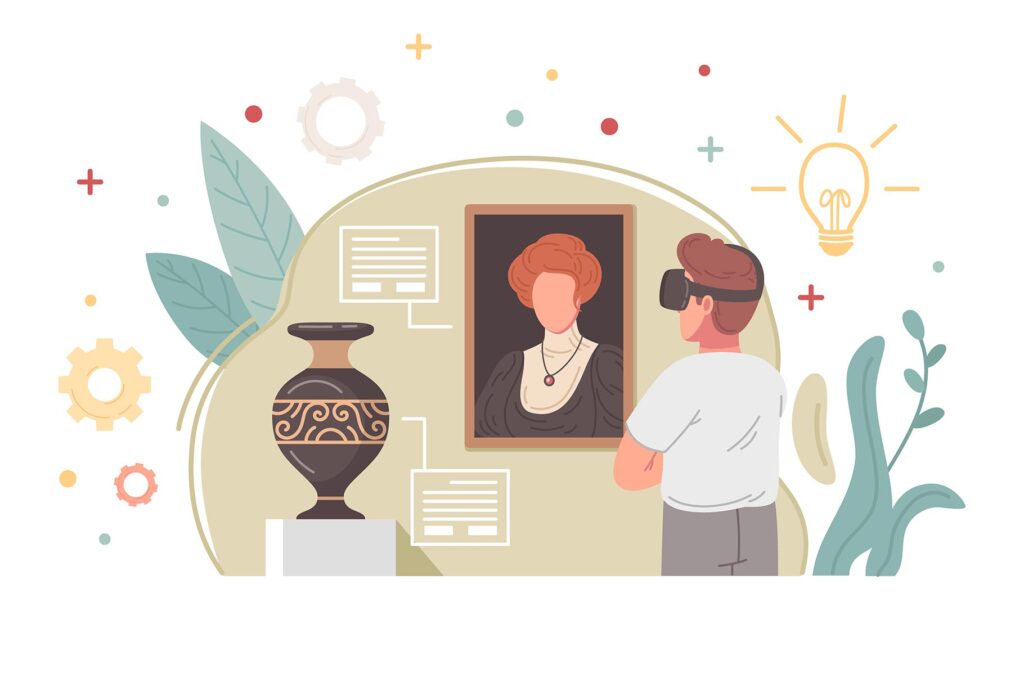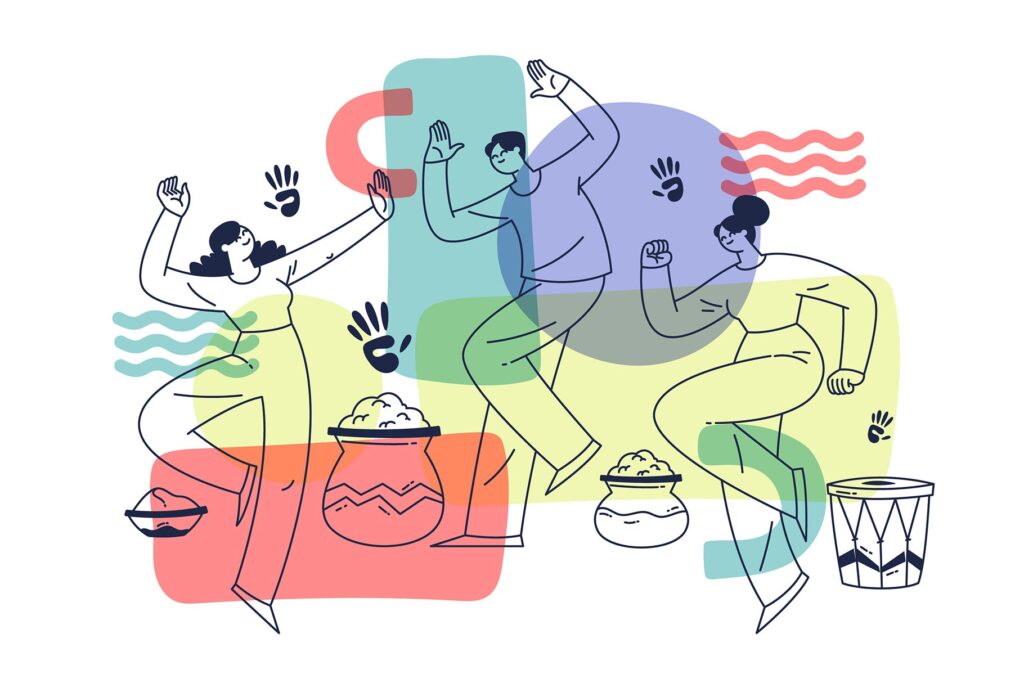The cultural influence on graphic design is a very important aspect of the field. It can be said that culture has been one of the key factors that have shaped and developed graphic design over time.
If it were not for culture, then we would not have such a wide variety of designs and influences in our world today.
As the world becomes more globalized, the need for graphic designers who can connect with diverse audiences continues to grow.
Graphic designers must be able to communicate effectively with the audience they are trying to reach. This is why it’s important for designers to understand what culture is and how it affects their designs.
In this post, we’ll explore how cultural heritage shapes modern graphic design and how you can use that knowledge to create effective designs that resonate with your audience.
History of Graphic Design

Graphic design has a long and varied history, which can be broken down into three main eras: pre-modernism (1850–1910), modernism (1910–1970), and post-modernism (1970–present).
Pre-modernism was a time when graphic design was most heavily influenced by the art world. It was primarily used for advertising and commercial purposes, rather than artistic ones.
Modernism emerged from this era and saw the rise of artists like Wassily Kandinsky and Piet Mondrian who were inspired by geometric abstraction.
Post-modernism is marked by an emphasis on irony and humor, as well as using pop culture references in design work.
Graphic design is a field of visual communication that includes the use of typography, photography, illustration, and page layout techniques to convey information and messages to a target audience.
The term graphic design can also refer to the work of an artist who uses any of these elements in combination with others: color or color scheme; images; symbols (logos); text; and/or layout.
Graphic designers create visual concepts for everything from print advertisements to websites. Most graphic designers specialize in one or more areas such as corporate identity design or advertising campaigns for specific products.
Ancient Traditions and Modern Designs

Culture is the foundation of graphic design. The importance of cultural heritage in graphic design can’t be overstated, and this article will show you how it shapes the way we see the world around us.
The earliest examples of graphic design are found in the cave paintings of Lascaux, France. These ancient designs were created for a variety of purposes including hunting magic or spirituality.
The images included animals, humans, and abstract patterns. These cave paintings demonstrate the importance of cultural heritage in graphic design.
It’s also important to note that these cave paintings were created by a diverse group of people. The images weren’t made by one culture or one person; rather, they were created by many different groups of people with their own unique styles.
This demonstrates how cultural heritage influences graphic design today.
In order to understand how culture influences graphic design, we must first examine what culture means.
Merriam-Webster defines culture as: “the beliefs, customs, and arts of a people at a particular time” or “the way that people live together in groups.”
This means that culture is not just something you are born into, it’s also something that evolves over time. This can be seen in the many different styles of cave paintings throughout history.
The earliest cave paintings were created by people who had never seen a drawing before and therefore didn’t know how to make one; however, as these groups of people continued to live together and interact with one another, their styles evolved into more advanced forms of art.
Also, read Storytelling: A Practical Tool in Graphic Design
Symbolism and Iconography

Symbolism and iconography are important elements of graphic design. These two components can be used to convey a message that transcends language barriers, allowing the designer to reach a broader audience.
However, it’s important to note the difference between symbols and icons:
A symbol is a concrete object or image, such as an icon on a computer screen, that represents something else. For example, an apple may represent knowledge or temptation; a cross could represent Christianity; and a heart is often used as shorthand for love.
An icon is an image used to represent something on your computer desktop or smartphone screen–like an envelope for emailing files, or an exclamation point next to text indicating excitement about what has been said so far!
Symbols and icons can be used in design to help simplify information and make it more accessible. They are often used as shorthand for ideas or concepts that may be unfamiliar to the audience.
For example, if you’re designing a website for children, an icon of a computer could represent a school; or an image of a house might represent a home.
Symbols and icons have played a large role in our history as graphic designers. They were used by ancient civilizations as a way to communicate ideas and concepts that were hard to describe using words alone.
For example, the symbol of an eye was used by the Egyptians to represent good health; the Greeks would use an image of the sun to indicate power or authority.
Cultural Aesthetics in Graphic Design

The patterns, colors, and fonts used in graphic design reflect the cultural aesthetics of society. They are not merely ornamental embellishments; rather these elements carry profound cultural connotations that represent a group or community’s identity
The cultural symbolism of patterns makes them a potent means to communicate feelings and tell stories.
For example, geometric patterns in Islamic art express a sense of oneness with Allah and the transcendent nature of divinity. In contrast, traditional African tribal designs convey lineage and social order.
Graphic designers can use elements of other cultures in their work to make it more appealing and understandable to people from different backgrounds.
Colors can also have cultural significance—they may be given different meanings depending on the culture.
For example, in Western cultures white is associated with purity and sadness while red symbolizes luck and happiness in Chinese culture.
Graphic designers can take advantage of the cultural signals that colors carry by creating designs that will reinforce their brands or products.
Culture can also influence typography—especially the use of scripts and calligraphic techniques in design. For example, designers might include elements that are particular to a given country or region as part of their works.
Typography can be used to express the history of a culture. For example, designs influenced by early 20th-century European art movements may include Art Nouveau lettering.
Incorporating cultural aesthetics into the graphic design not only produces more attractive results but also helps designers develop cultural awareness and celebrate diversity.
It requires an understanding of many cultures and a sensitivity to their distinctive aestheticsGraphic designers may make designs that are universal by embracing cultural aesthetics.
You may also like Why is Graphic Design Important to Your Brand?
Cultural Narratives in Graphic Design

In graphic design, the narrative power of cultural stories is often overlooked. Designers can use their creative work to tell rich and meaningful stories that go beyond words—bridging language barriers and bringing people together in a shared experience.
Illustrations, symbols, and compositions can be used to evoke emotions (such as fear), spark curiosity (about the future) or convey cultural messages.
By carefully selecting and arranging these elements, graphic designers can create narratives that reflect the history, mythology, or folklore—or any other aspect of a culture.
Graphic design can express cultural narratives in diverse ways, for example by showcasing a community’s journey or capturing the essence of an historical event. It could also bring to life traditions and rituals that define a culture.
Designers can shape and reinforce a brand’s image with carefully considered visual choices; in so doing, they evoke an emotional response from consumers.
Furthermore, cultural narratives in graphic design serve as a means of preserving culture by promoting awareness and understanding.
As stories about cultures are told and heard, people begin to understand one another better.
Indigenous Art and Design

Indigenous art and design are vital to preserving cultural identity, through graphic expression. The traditions and history of indigenous communities reflect their connection to the land:
By incorporating indigenous art and design principles into contemporary graphic expressions, designers can help preserve and celebrate the unique cultures that they come from.
Indigenous art reflects the unique worldview, beliefs, and values of Indigenous peoples.
Designers can draw inspiration from indigenous art forms such as dot painting, petroglyphs, and weaving patterns; this will both honor the cultural heritage and enhance the aesthetic quality of their work.
Cultural identity is best expressed through forms of art that are rooted in the history, traditions, and social milieu of a culture.
It requires working with indigenous artists, elders, and cultural advisors to accurately represent them and avoid cultural appropriation.
By involving indigenous people in the design process, designers can create designs that authentically represent and celebrate their cultures.
Cultural Icons and Symbols

Cultural icons and symbols are powerful tools for graphic designers. They can be used to communicate a message, convey a mood or emotion, or even playfully poke fun at something that’s happening in society.
The definition of what constitutes cultural iconography varies from person to person; however, there are some common items that we all recognize as being culturally significant such as national flags and religious symbols like crosses or crescents.
The use of cultural icons and symbols in graphic design has become a popular trend, particularly among designers who want to incorporate their ethnicity into their work.
This is often done by incorporating symbols that represent the culture or heritage of the designer such as those associated with sports teams or even local landmarks.
Read our trending post on Graphic Design and Environmental Sustainability (The Ultimate Guide)
Cross-Cultural Communication through Graphic Design

To avoid cultural appropriation, graphic designers should be aware of how their work may be perceived by others.
Cultural appropriation is when a person or group adopts certain aspects of another culture without understanding or respecting its historical significance.
For example, if you were designing a logo for an Asian restaurant and used the image of the Buddha in your design, this could be seen as disrespectful and offensive because it’s not part of your own culture.
To use cultural symbols in your designs, you can employ them respectfully or creatively. If you want to use a symbol from another culture for the meaning alone –for example, using Chinese characters as part of an illustration—then be sure that what you’re doing doesn’t imply that all Asians do XYZ.
Instead, focus on learning more about each individual person so that any stereotypes associated with their race are avoided altogether!
Cultural Appropriation vs. Cultural Appreciation in Graphic Design

For graphic designers, the difference between cultural appreciation and appropriation is a crucial one to think about.
Cultural appropriation occurs when a dominant culture adopts or adapts someone else’s cultural practices—such as clothing, music styles, and art forms—and distorts or exploits them.
Cultural appreciation involves engaging with and drawing inspiration from diverse cultures, acknowledging their origins, and honoring them.
In graphic design, navigating this line requires sensitivity and awareness. To understand the cultural context of elements being used—and seek permission from communities when appropriate.
We should reject stereotypes and seek out authentic cultural expressions. To be culturally sensitive, you should learn about and experience different cultures.
To create a better world, designers must be humble and open-minded as they seek to understand other cultures.
When designers take an inclusive approach, they can create art and products that celebrate people from all cultures.
Conclusion
We hope this article has helped you to better understand the cultural influences on graphic design. As a designer, it is important to be aware of these trends and how they affect your work. We encourage you to explore more about how culture influences other aspects of life as well !”
Recommended reading: Impact of AI on Graphic Design: Better Than Human?
FAQs
How graphic design is influenced by culture?
Graphic design is a form of visual communication that uses visual elements to convey a message. Graphic designers often work with culture, as they use their designs to influence how people think and feel about a brand or product.
What is the role of culture in graphic design?
The role of culture in graphic design is to help the designer understand the different ways people communicate and interact with each other. It helps a designer understand what kinds of messages people want to send, how they want those messages communicated, and how they want them received.
How does culture influence creativity?
Culture can influence creativity in a number of ways. For example, it may shape the way that people interact with one another and therefore their ability to collaborate on creative ideas. It can also influence the level of comfort people feel discussing new concepts or ideas, which can make it easier or harder for them to innovate.
Why is creative culture important?
Creative culture is important because it encourages people to push themselves and think outside the box. It allows them to take risks and be innovative, which is why creative companies are often more successful than their competitors.
2 thoughts on “The Cultural Influences on Graphic Design (Secrets Unveiled)”